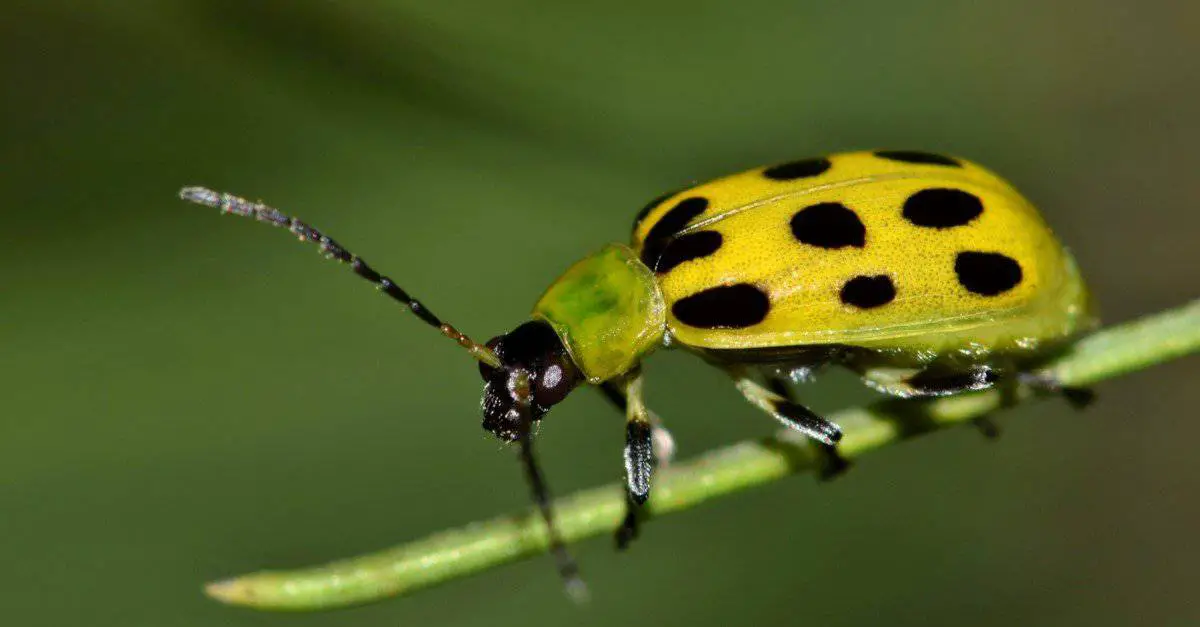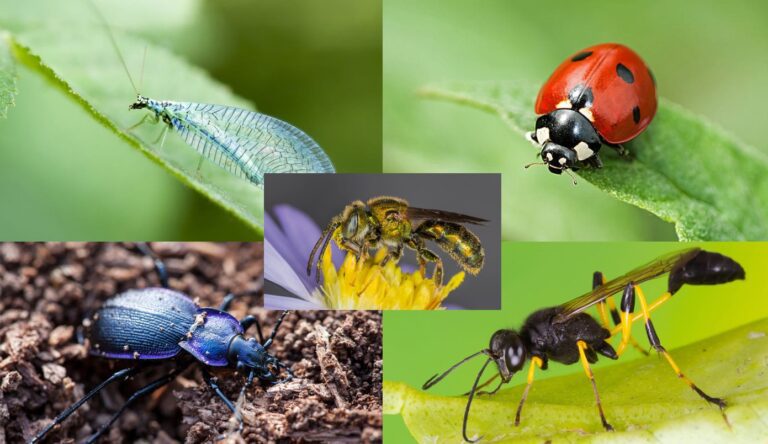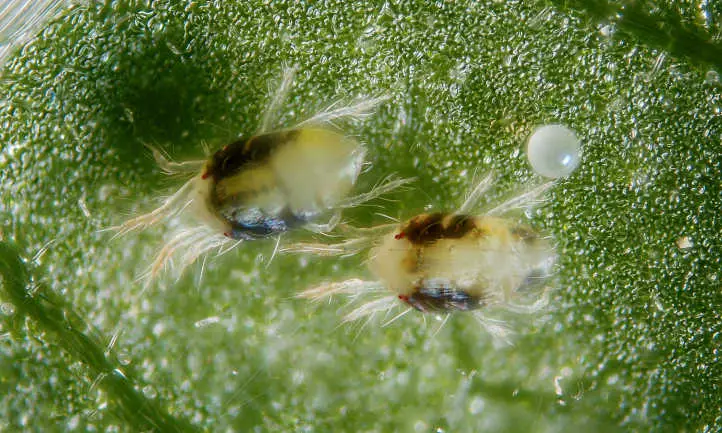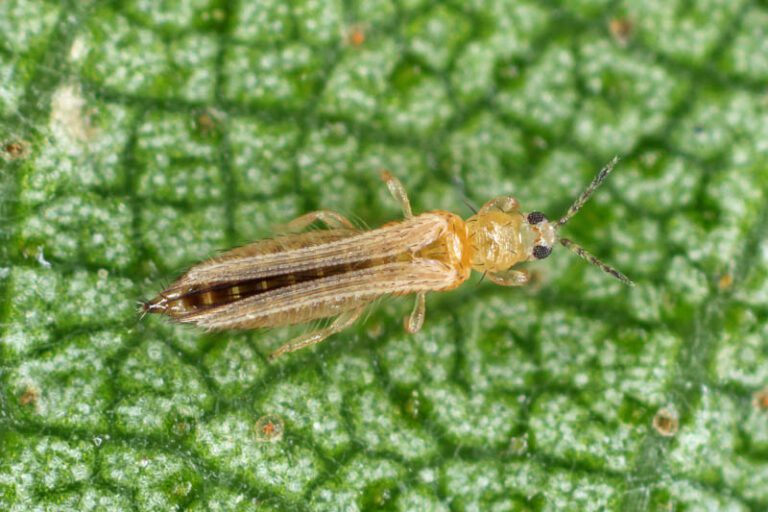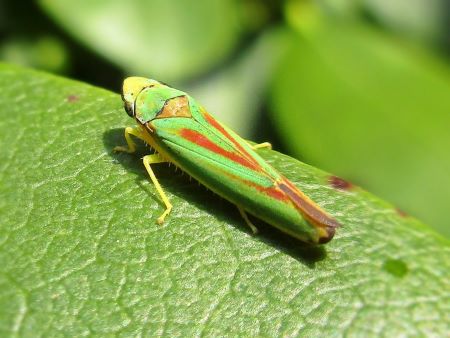How to Recognize and Repair Cucumber Beetle Damage in Your Garden
Introduction
Cucumber beetles are small, oval-shaped beetles that feed on cucurbit crops, such as cucumbers, squash, melons, and pumpkins. They can cause serious damage to your garden by chewing on the leaves, stems, flowers, and fruits of the plants, and by spreading bacterial wilt disease and cucumber mosaic virus. In this article, you will learn how to identify cucumber beetles, how to spot the signs of their damage, and how to repair and prevent their damage using natural or chemical methods.
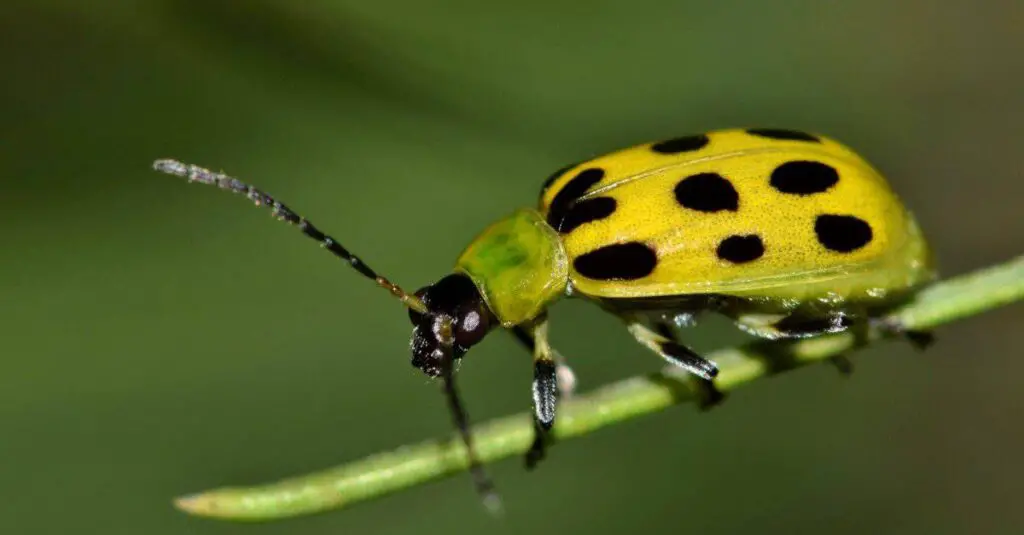
There are two main types of cucumber beetles: the striped cucumber beetle (Acalymma vittatum) and the spotted cucumber beetle (Diabrotica undecimpunctata). They have a yellow-green body with black stripes or spots on their back, and a black head and antennae. They are about 1/4 inch long, and can be found on the plants or in the soil near the plant bases. They have a complete life cycle, which means they go through four stages: egg, larva, pupa, and adult. They can have 2 to 3 generations per year, depending on the climate and the availability of host plants.
Cucumber beetles are harmful because they can reduce the yield and quality of your cucurbit crops by feeding on the plants and transmitting diseases.
- They can create holes, scars, wilting, and stunting on the leaves, stems, flowers, and fruits of the plants, which can affect the growth and development of the plants.
- They can also carry bacterial wilt disease, which is caused by a bacterium that clogs the vascular system of the plants, causing them to wilt and die. The bacteria can be transmitted by the beetles through their mouthparts or fecal matter.
- They can also carry cucumber mosaic virus, which is a viral disease that causes mosaic patterns, yellowing, and distortion on the leaves and fruits of the plants. The virus can be transmitted by the beetles through their saliva or body fluids.
If you want to protect your garden from cucumber beetles and their damage, you need to know how to recognize and repair their damage. In the following sections, you will learn how to monitor and manage cucumber beetles using various methods, such as traps, row covers, trap crops, biological control agents, or insecticides. You will also learn how to repair the damage caused by cucumber beetles, such as pruning infected stems, removing damaged fruits, and applying fungicides or bactericides. By following these tips, you can enjoy a healthy and productive cucurbit garden.
How to Recognize Cucumber Beetle Damage
Cucumber beetles are small, oval-shaped beetles that feed on cucurbit crops, such as cucumbers, squash, melons, and pumpkins. They can cause serious damage to your garden by chewing on the leaves, stems, flowers, and fruits of the plants, and by spreading bacterial wilt disease and cucumber mosaic virus. In this section, you will learn how to recognize the different types of damage that cucumber beetles can cause to your plants, and how to distinguish them from other types of damage.
Types of Cucumber Beetle Damage
Cucumber beetle damage can be classified into three types: foliar damage, fruit damage, and disease transmission.
- Foliar damage: This is the most visible type of damage, as it affects the leaves and stems of the plants. Cucumber beetles can create holes, scars, wilting, and stunting on the leaves and stems, which can affect the growth and development of the plants. The damage can be more severe on young plants, as they are more vulnerable to defoliation and girdling. The following pictures show some examples of foliar damage caused by cucumber beetles:
Holes and scars on cucumber leaves
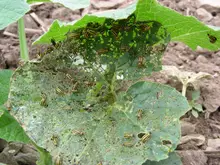
Wilting and stunting on squash plants
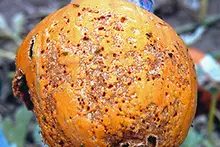
Girdling on pumpkin stem
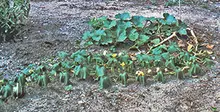
- Fruit damage: This is the type of damage that affects the quality and yield of the crop, as it affects the flowers and fruits of the plants. Cucumber beetles can feed on the flowers and reduce the pollination and fruit set of the plants. They can also feed on the fruits and create deep marks and pock marks on the rind, which can make the fruits unattractive and susceptible to rotting. The following pictures show some examples of fruit damage caused by cucumber beetles:
Scars and pock marks on cucumber fruit

Scars and pock marks on melon fruit

- Disease transmission: This is the most serious type of damage, as it affects the health and survival of the plants. Cucumber beetles can carry and transmit bacterial wilt disease and cucumber mosaic virus, which are two devastating diseases for cucurbit crops. Bacterial wilt disease is caused by a bacterium that clogs the vascular system of the plants, causing them to wilt and die. The bacteria can be transmitted by the beetles through their mouthparts or fecal matter. Cucumber mosaic virus is a viral disease that causes mosaic patterns, yellowing, and distortion on the leaves and fruits of the plants. The virus can be transmitted by the beetles through their saliva or body fluids. The following pictures show some examples of disease symptoms caused by cucumber beetles:
Bacterial wilt on cucumber plant
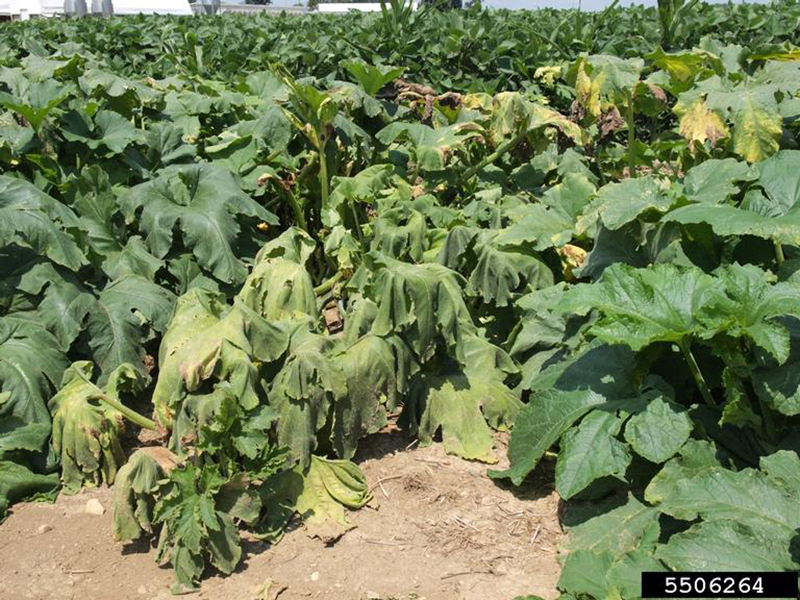
Cucumber mosaic virus on squash plant
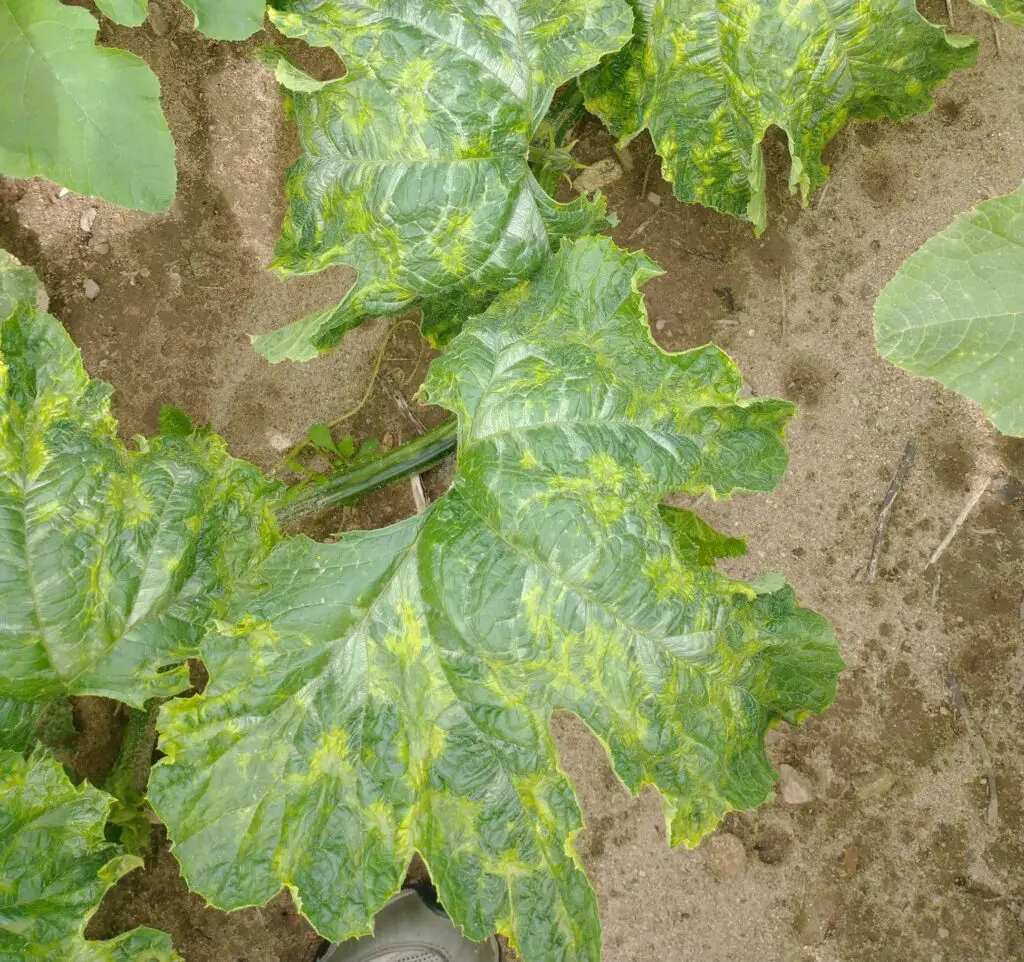
How to Distinguish Cucumber Beetle Damage from Other Types of Damage
Cucumber beetle damage can sometimes be confused with other types of damage, such as fungal infections, hail damage, or animal browsing. However, there are some clues that can help you to distinguish them.
- Fungal infections: Some fungal diseases, such as powdery mildew, anthracnose, or downy mildew, can also cause spots, lesions, or wilting on the leaves and fruits of cucurbit plants. However, fungal infections usually have a different appearance and pattern than cucumber beetle damage. For example, powdery mildew causes white, powdery patches on the leaves, anthracnose causes sunken, brown spots on the fruits, and downy mildew causes angular, yellow spots on the leaves with grayish fuzz on the undersides. Fungal infections can also be confirmed by using a magnifying glass or a microscope to look for the presence of fungal spores or structures.
- Hail damage: Hail can also cause holes and scars on the leaves and fruits of cucurbit plants. However, hail damage usually has a more random and irregular distribution than cucumber beetle damage. Hail damage can also be distinguished by looking for other signs of hail, such as broken branches, dented cars, or damaged roofs.
- Animal browsing: Some animals, such as deer, rabbits, or groundhogs, can also feed on the leaves and fruits of cucurbit plants. However, animal browsing usually leaves larger and more jagged holes than cucumber beetle damage. Animal browsing can also be identified by looking for other signs of animal activity, such as tracks, droppings, or hairs.
How to Identify the Type and Presence of Cucumber Beetles in Your Garden
To confirm that you have a cucumber beetle problem, you need to look for the beetles themselves, their eggs, or their feces. Here are some tips on how to identify the type and presence of cucumber beetles in your garden:
- Look for the beetles: The best time to look for the beetles is in the morning or evening, when they are more active and less likely to fly away. You can use a hand lens or a magnifying glass to examine the leaves, stems, flowers, and fruits of your cucurbit plants. You can also use a yellow sticky trap to catch the beetles and count them. The type of beetle can be determined by looking at the color and pattern of their wing covers. Striped cucumber beetles have three black stripes on a yellow background, while spotted cucumber beetles have 12 black spots on a yellow background.
- Look for the eggs: The eggs of cucumber beetles are pale orange-yellow and are laid in groups in cracks in the soil at the base of the host plants. The eggs are very small, about 1/25 inch long, and can be hard to see with the naked eye. You can use a hand lens or a magnifying glass to look for the eggs in the soil. You can also use a soil sieve or a fine mesh to filter the soil and collect the eggs.
- Look for the feces: The feces of cucumber beetles are black and granular, and can be found on the leaves, stems, or fruits of the host plants. The feces are also very small, about 1/50 inch long, and can be hard to see with the naked eye. You can use a hand lens or a magnifying glass to look for the feces on the plants. You can also use a white paper or a cloth to wipe the plants and collect the feces.
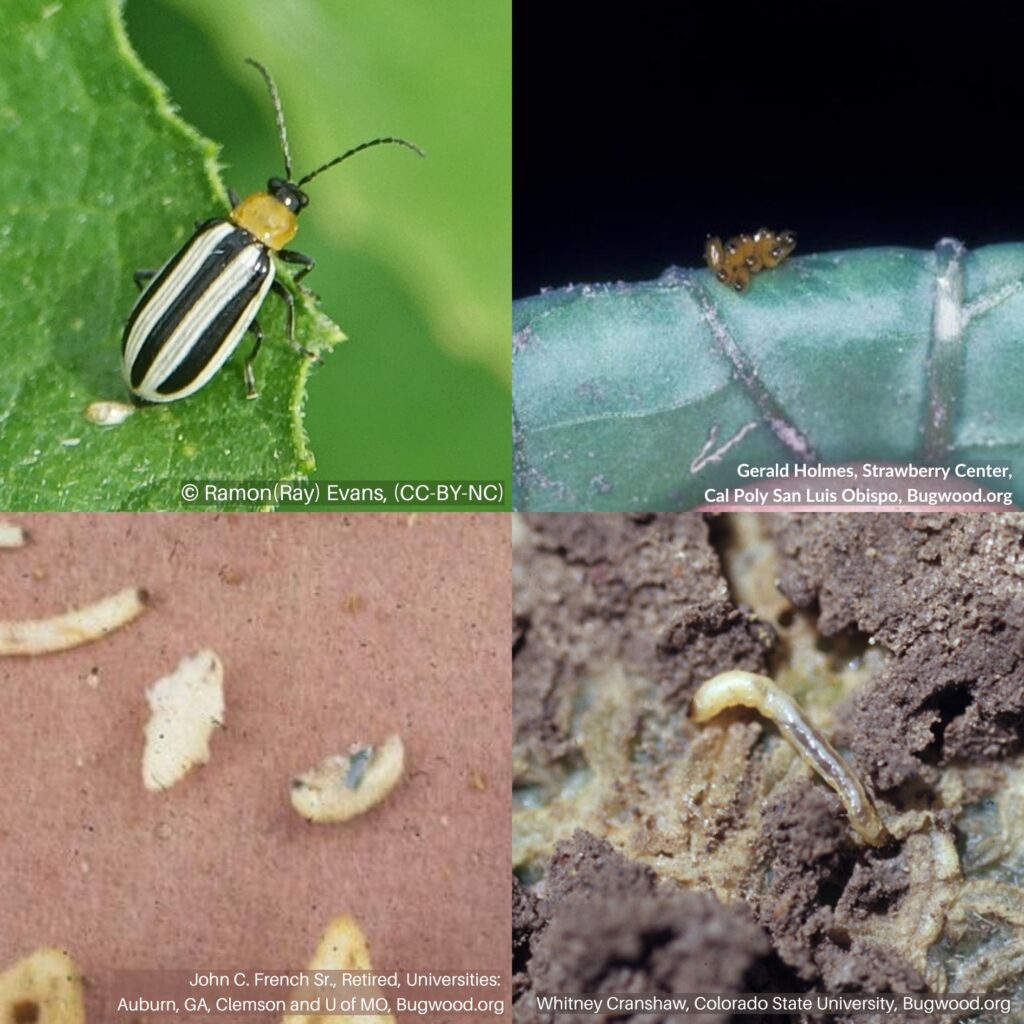
How to Repair Cucumber Beetle Damage
Cucumber beetles are small, oval-shaped beetles that feed on cucurbit crops, such as cucumbers, squash, melons, and pumpkins. They can cause serious damage to your garden by chewing on the leaves, stems, flowers, and fruits of the plants, and by spreading bacterial wilt disease and cucumber mosaic virus. In the previous section, you learned how to recognize the different types of damage that cucumber beetles can cause to your plants, and how to distinguish them from other types of damage. In this section, you will learn how to repair the damage caused by cucumber beetles, and how to restore the health and beauty of your plants.
General Principles of Repairing Cucumber Beetle Damage
The first step to repairing cucumber beetle damage is to control the beetles themselves, and prevent further damage. You can use various methods to monitor and manage cucumber beetles, such as traps, row covers, trap crops, biological control agents, or insecticides. You can find more details on how to use these methods in the next section. Once you have reduced the beetle population and their damage, you can focus on repairing the existing damage. Here are some general principles to follow:
- Prune: Pruning is the process of removing dead, damaged, or diseased parts of the plants, such as leaves, stems, or fruits. Pruning can help to improve the appearance, growth, and health of the plants, as well as to prevent the spread of diseases. You can use pruning shears, scissors, or a knife to cut off the affected parts, and dispose of them in a sealed bag or a trash can. Do not compost them, as they may contain beetles, eggs, or diseases. Prune the plants regularly, and sanitize your tools between cuts to avoid cross-contamination.
- Water: Watering is the process of providing adequate moisture to the plants, especially during dry or hot periods. Watering can help to prevent wilting, stress, and dehydration of the plants, as well as to promote their growth and development. You can use a hose, a sprinkler, a drip irrigation system, or a watering can to water the plants, depending on the size and location of your garden. Water the plants deeply and thoroughly, and avoid wetting the foliage, as it may increase the risk of fungal infections. Water the plants early in the morning or late in the evening, and avoid watering during the hottest part of the day, as it may cause evaporation or scorching.
- Fertilize: Fertilizing is the process of providing essential nutrients to the plants, such as nitrogen, phosphorus, potassium, calcium, magnesium, and iron. Fertilizing can help to boost the growth, yield, and quality of the plants, as well as to enhance their resistance to pests and diseases. You can use organic or synthetic fertilizers, granular or liquid forms, or slow-release or fast-acting types, depending on your preference and availability. Follow the label instructions for the dosage, frequency, and application method of the fertilizer, and avoid over-fertilizing, as it may cause nutrient imbalance or toxicity. Fertilize the plants during the active growing season, and avoid fertilizing during the dormant or flowering stages, as it may affect the plant’s development or reproduction.
- Mulch: Mulching is the process of covering the soil surface around the plants with a layer of organic or inorganic material, such as straw, wood chips, leaves, grass clippings, newspaper, plastic, or gravel. Mulching can help to conserve soil moisture, moderate soil temperature, suppress weeds, prevent soil erosion, and improve soil structure and fertility. You can use a rake, a shovel, or your hands to spread the mulch evenly around the plants, leaving a few inches of space around the stems to avoid rotting. Apply a 2 to 4 inch layer of mulch, and replenish it as needed throughout the season.
Specific Methods for Each Type of Damage
In addition to the general principles, you can also use some specific methods to repair each type of damage caused by cucumber beetles, such as foliar damage, fruit damage, and disease transmission.
- Foliar damage: This is the type of damage that affects the leaves and stems of the plants, causing holes, scars, wilting, and stunting. To repair foliar damage, you can use the following methods:
- Remove infected stems: If the stems of your plants are infected with bacterial wilt disease, you need to remove them as soon as possible to prevent the disease from spreading to the rest of the plant or other plants. You can use a sharp knife or pruning shears to cut off the infected stems at the base, and dispose of them in a sealed bag or a trash can. Do not compost them, as they may contain the bacteria. Sanitize your tools between cuts to avoid cross-contamination.
- Apply healing agents: If the leaves or stems of your plants are damaged by cucumber beetles, you can apply some healing agents to help them recover and heal faster. You can use natural or commercial products, such as aloe vera gel, honey, or wound sealant, depending on your preference and availability. Follow the label instructions for the dosage, frequency, and application method of the product, and avoid applying too much, as it may cause clogging or burning. Apply the product gently and carefully to the damaged areas, and avoid touching the healthy parts of the plants.
- Cover the wounds: If the wounds on the leaves or stems of your plants are large or exposed, you can cover them with some protective material to prevent further damage or infection. You can use natural or synthetic materials, such as paper, cloth, or tape, depending on your preference and availability. Cut the material to fit the size and shape of the wound, and secure it with a string, a clip, or a staple. Change the material regularly, and remove it when the wound is healed.
- Fruit damage: This is the type of damage that affects the quality and yield of the crop, causing scars and pock marks on the fruits. To repair fruit damage, you can use the following methods:
- Remove damaged fruits: If the fruits of your plants are damaged by cucumber beetles, you need to remove them as soon as possible to prevent them from rotting or attracting more pests. You can use your hands or a knife to harvest the damaged fruits, and dispose of them in a sealed bag or a trash can. Do not compost them, as they may contain beetles, eggs, or diseases. Harvest the fruits regularly, and avoid leaving them on the ground or on the plants for too long.
- Apply healing agents: If the fruits of your plants are damaged by cucumber beetles, you can apply some healing agents to help them recover and heal faster. You can use natural or commercial products, such as aloe vera gel, honey, or wound sealant, depending on your preference and availability. Follow the label instructions for the dosage, frequency, and application method of the product, and avoid applying too much, as it may cause clogging or burning. Apply the product gently and carefully to the damaged areas, and avoid touching the healthy parts of the fruits.
- Cover the scars: If the scars on the fruits of your plants are large or exposed, you can cover them with some protective material to prevent further damage or infection. You can use natural or synthetic materials, such as paper, cloth, or plastic, depending on your preference and availability. Cut the material to fit the size and shape of the scar, and secure it with a string, a clip, or a staple. Change the material regularly, and remove it when the scar is healed.
- Disease transmission: This is the type of damage that affects the health and survival of the plants, causing bacterial wilt disease and cucumber mosaic virus. To repair disease transmission, you can use the following methods:
- Remove diseased plants: If the plants of your garden are infected with bacterial wilt disease or cucumber mosaic virus, you need to remove them as soon as possible to prevent the disease from spreading to the rest of the garden or other gardens. You can use your hands or a shovel to dig up the diseased plants, and dispose of them in a sealed bag or a trash can. Do not compost them, as they may contain the bacteria or the virus. Sanitize your tools and gloves after handling the diseased plants to avoid cross-contamination.
- Apply fungicides or bactericides: If the plants of your garden are infected with bacterial wilt disease or cucumber mosaic virus, you can apply some fungicides or bactericides to help them recover and prevent further infection. You can use organic or synthetic products, such as copper, sulfur, or streptomycin, depending on your preference and availability. Follow the label instructions for the dosage, frequency, and application method of the product, and avoid applying too much, as it may cause phytotoxicity or resistance. Apply the product thoroughly and evenly to the plants, and avoid contact with the fruits or the soil.
How to Prevent Cucumber Beetle Damage
Cucumber beetles are small, oval-shaped beetles that feed on cucurbit crops, such as cucumbers, squash, melons, and pumpkins. They can cause serious damage to your garden by chewing on the leaves, stems, flowers, and fruits of the plants, and by spreading bacterial wilt disease and cucumber mosaic virus. In the previous sections, you learned how to recognize and repair the different types of damage that cucumber beetles can cause to your plants. In this section, you will learn how to prevent cucumber beetle damage, and how to protect your plants from these pests.
General Principles of Preventing Cucumber Beetle Damage
The best way to prevent cucumber beetle damage is to adopt an integrated pest management (IPM) approach, which is a strategy that combines various methods to control pests in an effective, economical, and environmentally friendly way. IPM consists of three main principles: prevention, monitoring, and intervention.
- Prevention: Prevention is the process of reducing the risk or occurrence of pest infestation, by modifying the environment, the host, or the pest. Prevention can help to avoid or minimize the damage caused by pests, as well as to reduce the need for control measures. Some examples of prevention methods are:
- Crop rotation: Crop rotation is the practice of planting different crops in the same area in different seasons or years, to break the pest life cycle and reduce the pest population. Crop rotation can also improve soil fertility, nutrient availability, and weed suppression. For example, you can rotate your cucurbit crops with non-host crops, such as corn, beans, or peas, to prevent cucumber beetles from overwintering or reproducing in your garden.
- Resistant varieties: Resistant varieties are plants that have been bred or selected to have a higher tolerance or immunity to pests or diseases, compared to other varieties. Resistant varieties can reduce the damage and infection caused by pests or diseases, as well as the need for control measures. For example, you can choose cucurbit varieties that are resistant or tolerant to bacterial wilt disease or cucumber mosaic virus, to prevent cucumber beetles from transmitting these diseases to your plants.
- Cultural practices: Cultural practices are methods that involve the manipulation of the plant or the soil, to enhance the plant health and vigor, and to discourage the pest development and activity. Cultural practices can also improve the plant growth, yield, and quality, as well as the soil structure and fertility. Some examples of cultural practices are:
- Planting date: Planting date is the time when you sow or transplant your plants in your garden, according to the climate and the crop requirements. Planting date can affect the pest exposure and damage, as well as the plant growth and development. For example, you can plant your cucurbit crops early or late in the season, to avoid the peak emergence or activity of cucumber beetles in your area.
- Plant spacing: Plant spacing is the distance between the plants in your garden, according to the plant size and the crop requirements. Plant spacing can affect the pest infestation and damage, as well as the plant growth and yield. For example, you can space your cucurbit plants widely, to allow more air circulation and light penetration, and to reduce the pest attraction and movement.
- Weed control: Weed control is the process of removing or suppressing the unwanted plants in your garden, that compete with your crops for space, nutrients, water, and light. Weed control can also reduce the pest harbor and food source, as well as the pest transmission and damage. For example, you can control the weeds in your garden, especially those that are hosts or attractants for cucumber beetles, such as pigweed, lambsquarters, or ragweed.
- Monitoring: Monitoring is the process of observing and recording the pest population and damage, by using various tools and techniques, to determine the pest status and the need for control measures. Monitoring can help to detect the pest presence and activity, as well as to evaluate the effectiveness and impact of the control measures. Some examples of monitoring methods are:
- Visual inspection: Visual inspection is the method of looking for the pest or the damage on the plants or in the soil, by using your eyes or a magnifying glass, to identify the pest type and level. Visual inspection can also help to locate the pest source and distribution, as well as to assess the plant health and vigor. For example, you can inspect your cucurbit plants regularly, and look for the beetles, their eggs, their feces, or their damage on the leaves, stems, flowers, or fruits of the plants.
- Traps: Traps are devices that capture or kill the pest, by using various attractants or mechanisms, to measure the pest population and activity. Traps can also help to reduce the pest number and damage, as well as to provide early warning or indication of the pest infestation. For example, you can use yellow sticky traps, which are sheets of yellow paper or plastic coated with a sticky substance, to catch cucumber beetles and other pests. You can place the traps near your cucurbit plants, and check them regularly. The number of beetles caught can indicate the level of infestation and the need for control measures.
- Lures: Lures are substances that attract the pest, by using various stimuli, such as color, odor, or sound, to monitor the pest population and activity. Lures can also help to enhance the effectiveness and specificity of the traps, as well as to manipulate the pest behavior or movement. For example, you can use clove oil, which is an essential oil extracted from the clove plant, to lure cucumber beetles and other pests. You can apply the oil to the traps, or to the plants or the soil, and observe the pest response. The amount of beetles lured can indicate the level of infestation and the need for control measures.
- Intervention: Intervention is the process of applying control measures, by using various methods or agents, to reduce the pest population and damage, when they exceed the economic threshold or the acceptable level. Intervention can help to protect the plant health and yield, as well as to prevent the pest outbreak or resurgence. Some examples of intervention methods are:
- Biological control: Biological control is the method of using natural enemies of the pest, such as predators, parasitoids, or pathogens, to suppress the pest population and damage, by feeding on, parasitizing, or infecting the pest. Biological control can also help to preserve the ecological balance and diversity, as well as to reduce the environmental impact and risk of the control measures. Some examples of biological control agents are:
- Predators: Predators are organisms that kill and consume the pest, by using various adaptations, such as mouthparts, claws, or venom. Predators can reduce the pest number and damage, as well as to regulate the pest population and behavior. For example, you can use ladybugs, which are small, oval-shaped beetles that feed on aphids, mites, and other pests, to control cucumber beetles and other pests. You can buy ladybugs from a garden center or an online store, and release them in your garden, or you can attract them by planting flowers, such as marigolds, sunflowers, or yarrow, in your garden.
- Parasitoids: Parasitoids are organisms that live on or in the pest, and eventually kill the pest, by using various adaptations, such as ovipositors, venom, or symbionts. Parasitoids can reduce the pest number and damage, as well as to disrupt the pest life cycle and reproduction. For example, you can use braconid wasps, which are small, black wasps that lay their eggs inside the larvae or pupae of beetles, moths, and other pests, to control cucumber beetles and other pests. You can buy braconid wasps from a garden center or an online store, and release them in your garden, or you can attract them by planting flowers, such as dill, fennel, or parsley, in your garden.
- Pathogens: Pathogens are microorganisms that cause disease or death to the pest, by using various mechanisms, such as toxins, enzymes, or spores. Pathogens can reduce the pest number and damage, as well as to spread among the pest population and generation. For example, you can use Bacillus thuringiensis (Bt), which is a bacterium that produces a toxin that kills the larvae of beetles, moths, and other pests, to control cucumber beetles and other pests. You can buy Bt from a garden center or an online store, and apply it to your plants, or you can make your own Bt by fermenting some soil or compost.
- Chemical control: Chemical control is the method of using synthetic or natural substances, such as insecticides, to kill or repel the pest, by using various modes of action, such as contact, ingestion, or systemic. Chemical control can also help to provide quick and effective control of the pest, as well as to complement other control methods. However, chemical control can also have some drawbacks, such as harming beneficial insects, pollinators, and the environment, causing pest resistance or resurgence, or posing health and safety risks. Therefore, chemical control should be used as a last resort, and only when the pest population exceeds the economic threshold, which is the level of infestation that causes more damage than the cost of control. Some examples of chemical control agents are:
- Insecticides: Insecticides are chemicals that can kill or repel insects, and can be applied to the plants or the soil. However, insecticides can also harm beneficial insects, pollinators, and the environment, cause pest resistance or resurgence, or pose health and safety risks. Therefore, insecticides should be used as a last resort, and only when the pest population exceeds the economic threshold, which is the level of infestation that causes more damage than the cost of control. Some examples of insecticides that can be used against cucumber beetles are:
- Carbaryl: Carbaryl is a synthetic insecticide that works by affecting the nervous system of insects, causing paralysis and death. Carbaryl can be applied as a spray or a dust to the plants, and can provide broad-spectrum control of cucumber beetles and other pests. However, carbaryl can also kill beneficial insects, such as bees, ladybugs, and lacewings, and can contaminate the soil and water. Carbaryl can also be toxic to humans and animals, and can cause skin irritation, nausea, or headache. Therefore, carbaryl should be used with caution, and according to the label instructions, and with proper safety precautions.
- Permethrin: Permethrin is a synthetic insecticide that works by affecting the nervous system of insects, causing paralysis and death. Permethrin can be applied as a spray or a dust to the plants, and can provide long-lasting control of cucumber beetles and other pests. However, permethrin can also kill beneficial insects, such as bees, ladybugs, and lacewings, and can contaminate the soil and water. Permethrin can also be toxic to humans and animals, and can cause skin irritation, eye irritation, or respiratory problems. Therefore, permethrin should be used with caution, and according to the label instructions, and with proper safety precautions.
- Pyrethrins: Pyrethrins are natural insecticides that are derived from the flowers of the pyrethrum plant, and work by affecting the nervous system of insects, causing paralysis and death. Pyrethrins can be applied as a spray or a dust to the plants, and can provide fast and effective control of cucumber beetles and other pests. However, pyrethrins can also kill beneficial insects, such as bees, ladybugs, and lacewings, and can degrade quickly in sunlight and water. Pyrethrins can also be mildly toxic to humans and animals, and can cause skin irritation, eye irritation, or allergic reactions. Therefore, pyrethrins should be used with caution, and according to the label instructions, and with proper safety precautions.
- Neem oil: Neem oil is a natural insecticide that is extracted from the seeds of the neem tree, and works by affecting the growth, feeding, and reproduction of insects, causing reduced development, appetite, and fertility. Neem oil can be applied as a spray or a dust to the plants, and can provide selective and safe control of cucumber beetles and other pests. Neem oil can also repel insects, fungi, and bacteria, and can improve the plant health and vigor. Neem oil can also be harmless to beneficial insects, such as bees, ladybugs, and lacewings, and can be biodegradable and eco-friendly. Neem oil can also be non-toxic to humans and animals, and can cause no or minimal side effects. Therefore, neem oil can be a good alternative to synthetic insecticides, and can be used with confidence, and according to the label instructions, and with proper safety precautions.
- Biological control: Biological control is the method of using natural enemies of the pest, such as predators, parasitoids, or pathogens, to suppress the pest population and damage, by feeding on, parasitizing, or infecting the pest. Biological control can also help to preserve the ecological balance and diversity, as well as to reduce the environmental impact and risk of the control measures. Some examples of biological control agents are:
Conclusion
Cucumber beetles are destructive pests that can cause serious damage to your cucurbit crops, such as cucumbers, squash, melons, and pumpkins. They can feed on the leaves, stems, flowers, and fruits of the plants, and transmit bacterial wilt disease and cucumber mosaic virus. In this article, you learned how to recognize the different types of damage that cucumber beetles can cause to your plants, such as holes, scars, wilting, and stunting. You also learned how to repair the damage caused by cucumber beetles, such as pruning infected stems, applying healing agents, or covering fruit scars. Finally, you learned how to prevent cucumber beetle damage, using various methods, such as crop rotation, resistant varieties, cultural practices, traps, lures, biological control, or chemical control.

Suyash Dhoot, editor at SouthElMonteHydroponics.com, is a pioneering force in hydroponics. His expertise spans nutrient solutions and cutting-edge technology. Through meticulous editing, he elevates the site to a beacon of knowledge, offering invaluable insights. Dhoot’s dedication shapes a greener, more efficient future for agriculture.

